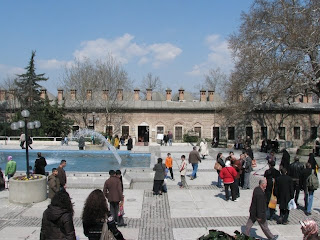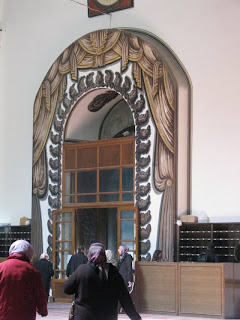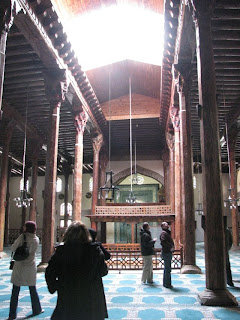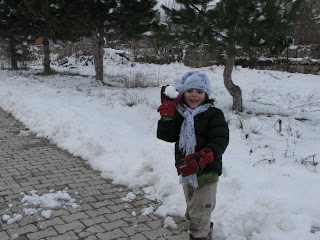
PANORAMIC VIEW OF BURSA
The earlier Byzantine walls of the city have been restored, but very poorly, and with no regard for their historical value.

AWFUL. JUST AWFUL.
Our first stop after the walls was the Shehadet Mosque. Originally built in 1365 by the Sultan Murad I, the building was extensively restored in the late 19th century. We did not go in, but stayed outside to inspect an extremely important inscription embedded in one of the walls.

Some scholars of Ottoman history consider this inscription to be the oldest datable example of the Ottoman script. Also, because the word "Gazi", or "holy warrior" appears in it, some historians have used it to bolster a theory that the Ottoman state was founded on the concept of holy war and the spread of Islam, rather than out of more purely political motivations and the desire to expand a state. It is fairly clear why this theory would be attractive to people of a certain mindset, but more current scholarly opinion is leaning away from this idea. Regardless, it is an important inscription for the study of Ottoman history.
From there we walked to the center of the town to see the 15th-century Han, which is still the center of sales of Bursa's most famous product: fine silk.

THE SQUARE OUTSIDE THE HAN

THE INTERIOR COURTYARD OF THE HAN
Our next stop was the Ulu Camii, a mosque constructed in 1399. The much later painting on the interior is quite interesting, especially an illusionistic representation of an arch over the main doorway.

EXTERIOR OF THE ULU CAMII

TROMP L'EOIL PAINTING ON THE MOSQUE'S INTERIOR
That evening we were to make a trip to the historic hamam (Turkish bath) for some relaxation. On the way we stopped at one more medieval mosque but, unfortunately, because we were on the way to the baths we had not brought our cameras. This was really too bad because the caretaker was kind enough to let some of us climb to the top of the minaret! This is a VERY rare occurrence. None of the Ottomanists had even ever been in a minaret. It was not one of the tallest I have seen, but was a good 50-60 feet. As it was so old, the balcony on which the muezzin used to stand to recite the call to prayer was quite narrow -- one person cannot pass another person on it. It also sloped down towards the outside quite steeply, and the stone railing came up only to about mid-thigh, so it definitely was not doing much to ensure safety! It is difficult to imagine climbing the narrow, pitch-black stairway to the top at dawn to stand on that small, high balcony and sing. We were very glad to have the opportunity to be up there, but we did not stay long!
The baths were very interesting. They are served by natural hot mineral springs, so the water in all the soaking pools is quite warm and heavy -- very relaxing. The mens' side is opulent, made up of a forest of Roman columns. The guys were treated to wraps of warm towels (refreshed periodically), cold drinks, and general extreme comfort. The women's side, however, is much smaller and less impressive, and entirely do-it-yourself (unless you purchase a scrub or a massage). No warm towels, no being waited on hand and foot. Of course, the price is the same (naturally). The one interesting aspect of the women's side is the "Lion's Mouth," which is actually a Roman drainpipe spout in the shape of a lion's head. At some point it was mounted on the wall where the hot spring enters the main chamber, and steaming water now pours out of its mouth. I have seen dozens of such spouts on ancient buildings, and lying around archaeological sites, but I'd never seen one in use.
INTERLUDE: A COUPLE OF INTERESTING IMAGES:

A WOMAN INSPECTS MOTORCYCLES OUTSIDE A MOSQUE

ONLY IN TURKEY: A PLAYGROUND CALLED "GUNPOWDER PARK" SET UP IN THE YARD OF A HIGH-VOLTAGE POWER STATION!
The next day, we started with a visit to the Yildirim Beyazid Camii. It is a small but attractive early 15th-century mosque, with later wall decoration. The most interesting aspect of the complex is the tomb of Beyazid I (1360-1403). He is perhaps best known as a character in the play Tamerlane by Christopher Marlowe. He was taken prisoner by Tamerlane (also called Timur) at the Battle of Ankara in 1403. Although he was originally buried near there, his body was later moved to this tomb in Bursa.

INTERIOR OF YILDIRIM BEYAZID CAMII

TOMB OF BEYAZID I
Our next stop was the Yesil Camii, dated 1412-1419. The tilework in that building is just unbelievable. Scott was able to get us access to the Sultan's loge, in the second story of the building. The deep blues, vibrant turqouise, and real gold inlay make a spectacular sight that cannot be adequately conveyed in photographs.

ME IN THE SULTAN'S LOGE

THE BEST PICTURE I COULD GET OF THE TILEWORK. DOESN'T EVEN COME CLOSE TO THE TRUE COLORS

THE VIEW DOWN TO THE FLOOR OF THE MOSQUE
Even the lower area of the mosque, for the use of common people, is covered in gorgeous tilework with inlaid gold:

We also visited the Turkish Islamic Art Museum. It was ok, but didn't blow anyone away. As usual, I was most interested in the mannequins dressed in traditional costumes. The courtyard also made a pleasant place to relax for a bit.

AS ALWAYS, THE MANNEQUINS ARE A BIT CREEPY

SOME OF THE FELLOWS RELAXING IN THE COURTYARD
Our final stop was the Muradiye Complex, a large grouping of tombs of Ottoman nobility. The setting is pleasant, quiet, and green.

Among the most interesting tombs is that of Cem Sultan (pronounced "Jim"), a rather dashing figure in late 15th-century Ottoman history. He was the younger brother of the ruling sultan, who chose to get rid of him by sending him into exile in Rome where he dallied with many women of high society and made quite a name for himself as a ladies' man and a cultured man-about-town. He died mysteriously in 1495, most likely poisoned by his brother. His tomb is incredibly garish on the interior, and one cannot help but think that his brother, while making an attempt to feign honor of his sibling, was also taking a bit of a last dig at him by decorating his final resting place in such an over-the-top and fairly unattractive way.

THE EXTERIOR OF CEM SULTAN'S TOMB

THE INTERIOR OF CEM SULTAN'S TOMB

THE COLORS ACTUALLY WORK IN THE DOME
Another tomb of interest is that of Prince Mustafa, the son of Suleyman the Magnificent. He died in 1553 and his tomb is covered on the interior with Iznik tiles of the highest quality. These tiles are in such high demand on the art market that some thieves with no sense of decency had recently broken into the tomb in the middle of the night and pried some off, breaking several in the process. They will have great difficult moving them, since they will be immediately recognizable to any Ottoman art historian who might be called on to make a ruling on their authenticity for purposes of valuation. Here's hoping they do get caught!

ALYSON, A HISTORIAN OF OTTOMAN ARCHITECTURE, INSPECTS THE RECENT DAMAGE.
Our two days in Bursa drawing to a close, we took the ferry back to Istanbul. Coming into the city from the west, we were rewarded with a view of Sultanahmet that is not often appreciated. Most photographs are taken from the Golden Horn, so images of the familiar skyline of the historic area almost always show Hagia Sophia in front of the blue Mosque. Coming in the way we did, the familiar vista was reversed. This is interesting and important, because it gives an opportunity to really appreciate how massive the dome of Hagia Sophia is. With the Blue Mosque sitting in front of it, closer to the viewer, it is obvious how huge the 6th-century building behind it really is -- even so much further from the viewer, it's dome is clearly huge in comparison to the domes of the Blue Mosque -- and how it effectively dwarfs the later construction.

The other thing we could appreciate from the water, of course, was the disgusting blanket of pollution that sits over the city. Sigh. Home again.












































